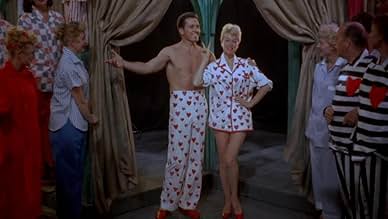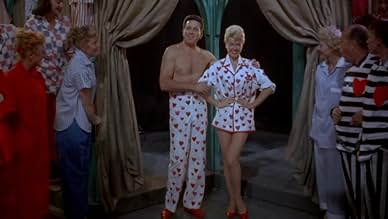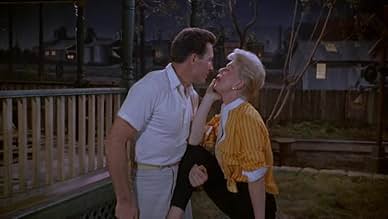John Raitt(1917-2005)
- Actor
- Soundtrack
One of the prime Broadway musical stars of the post WWII period, handsome John Raitt was once described by composer Richard Rodgers as "a big, brawny fellow with a magnificent baritone." John would go on to maintain an incredibly resilient career spanning over 60 years, showing remarkable power, range and stamina for a man who defied the odds as he continued concertizing well into his 80s.
He was born John Emmet Raitt in Santa Ana, California on January 29, 1917, the son of Archie John Raitt, founder and director of the North Orange County Young Men's Christian Association. His interest in theatre developed while attending Fullerton Union High School in Fullerton where he appeared in several plays at the local Plummer Auditorium and sang in the chorus of "The Desert Song." Also excelling in football and track, he won the state title in the shot-put in 1935, which, in turn, earned him a track scholarship to USC. A year later, however, he transferred to the University of Redlands and received his degree in physical education.
Having also studied classical voice at the university, he appeared in their productions of "The Bartered Bride" and "Die Fledermaus." With singing winning out over a high school gym teaching career, John intently studied voice under Richard Cummings while performing at rotary clubs and YMCAs. One of his first appearances would be in the chorus of "HMS Pinafore" with the Los Angeles Civic Light Opera Company in 1940. Moving up into prime roles the following year, John the leading roles of played Figaro and Count Almaviva in "The Barber of Seville," Escamillo in "Carmen, as well as leads in "Rose Marie" and "The Merry Widow." After extensive training, John saw himself better suited to musical theatre than opera.
MGM saw promise in John as a leading man, signed him and groomed him in bit roles in both war-era musicals (Little Nellie Kelly (1940) starring Judy Garland and Ship Ahoy (1942) starring Eleanor Powell) and stoic dramas (Flight Command (1940), H.M. Pulham, Esq. (1941)). Discouraged at his complete lack of acceleration, John continued performing musical stage leads and earned his huge career break when he won the role of Curly in the Chicago production of the new big hit musical "Oklahoma!" in 1944. As such, he abandoned Hollywood and moved to New York.
Critics took notice of the man's robust presence, sturdy pipes and unfailing confidence. The virile man with the sly flash in his eye then made his Broadway debut originating the role of the tormented carnival barker Billy Bigelow in the now-classic 1945 musical "Carousel." He never had to look back. John's powerful rendition of the "Soliloquy" number helped him to clinch the prestigious New York Drama Critics and Donaldson Awards as well as being one of the first recipients of the Theatre World Award for "Promising Personalities." Surprisingly, he was not nominated for a Tony Award for this or any other performance. Nevertheless, John continued to impress on Broadway despite the short runs of "Magadalena" (1948), "Three Wishes for Jamie" (1952) and "Carnival in Flanders" (1953).
TV took notice and John showcased on many of the popular musical variety shows of the day, making his debut on "The Ed Wynn Show" in 1949. Others programs would include "The Buick Circus Show," "The Jane Froman Show," "The Milton Berle Show," "The Colgate Comedy Hour," The Ed Sullivan Show," "The Dinah Shore Chevy Show," "The Steve Allen Playhouse," Shirley Temple's Storybook Theatre" and "The Bell Telephone Hour," among others. In 1957 he played Frank Butler opposite Mary Martin's Annie Oakley in an NBC-TV production of Annie Get Your Gun (1957) and was given straight acting roles in such dramatic fare as "General Electric Theater" and "Death Valley Days."
In 1954, John originated his second signature role as foreman Sid Sorokin in "The Pajama Game" opposite Janis Paige. Here, he introduced the classic ballad "Hey There" for which he is arguably best known. So ideally suited was he in this role that John was asked to transfer Sid to film, this time co-starring with Doris Day. Although the movie was an unqualified success, musical films were on their way out and he did not find any more work in the area of cinema.
For the next few decades, John would dedicate himself with tours of the roles audiences had grown to love (Curly, Billy, Sid). Raitt's two other Broadway ventures, the musical A Joyful Noise (1966) and the revue A Musical Jubilee (1975), closed early. Additional vehicles that suited him on the road included "Camelot," "Shenandoah," "1776," "South Pacific," "Man of La Mancha," "Kismet, "New Moon," Zorba" and "Fiddler on the Roof." Out of nowhere, John played a singing trucker in a 1986 TV episode of "Third Rock from the Sun."
The elderly Raitt continued performing strongly into his eighties, touring in his one-man show "An Evening with John Raitt" in which he sang 23 songs from 16 Broadway musicals. He was inducted into the Theatre Hall of Fame in 1994 and the Hollywood Bowl Hall of Fame in 2001. He recorded 14 albums in all, including John Raitt: The Broadway Legend (1995). The live musical and concert stages would be John's invaluable legacy to the music world -- there he was always "First Raitt!"
In 1942, John married pianist Marjorie Haydock. One of their three children grew up to become renowned blues/rock singer, songwriter and guitarist Bonnie Raitt, who obviously inherited her father's musical talent. They often performed in concert together in later years. Son David Raitt became a graphic and title designer. Living in the Pacific Palisades area of Los Angeles, the veteran singer died at 88 on February 20, 2005, of complications from pneumonia. Divorced twice, he was survived by third wife, Rosemary Kraemer.
He was born John Emmet Raitt in Santa Ana, California on January 29, 1917, the son of Archie John Raitt, founder and director of the North Orange County Young Men's Christian Association. His interest in theatre developed while attending Fullerton Union High School in Fullerton where he appeared in several plays at the local Plummer Auditorium and sang in the chorus of "The Desert Song." Also excelling in football and track, he won the state title in the shot-put in 1935, which, in turn, earned him a track scholarship to USC. A year later, however, he transferred to the University of Redlands and received his degree in physical education.
Having also studied classical voice at the university, he appeared in their productions of "The Bartered Bride" and "Die Fledermaus." With singing winning out over a high school gym teaching career, John intently studied voice under Richard Cummings while performing at rotary clubs and YMCAs. One of his first appearances would be in the chorus of "HMS Pinafore" with the Los Angeles Civic Light Opera Company in 1940. Moving up into prime roles the following year, John the leading roles of played Figaro and Count Almaviva in "The Barber of Seville," Escamillo in "Carmen, as well as leads in "Rose Marie" and "The Merry Widow." After extensive training, John saw himself better suited to musical theatre than opera.
MGM saw promise in John as a leading man, signed him and groomed him in bit roles in both war-era musicals (Little Nellie Kelly (1940) starring Judy Garland and Ship Ahoy (1942) starring Eleanor Powell) and stoic dramas (Flight Command (1940), H.M. Pulham, Esq. (1941)). Discouraged at his complete lack of acceleration, John continued performing musical stage leads and earned his huge career break when he won the role of Curly in the Chicago production of the new big hit musical "Oklahoma!" in 1944. As such, he abandoned Hollywood and moved to New York.
Critics took notice of the man's robust presence, sturdy pipes and unfailing confidence. The virile man with the sly flash in his eye then made his Broadway debut originating the role of the tormented carnival barker Billy Bigelow in the now-classic 1945 musical "Carousel." He never had to look back. John's powerful rendition of the "Soliloquy" number helped him to clinch the prestigious New York Drama Critics and Donaldson Awards as well as being one of the first recipients of the Theatre World Award for "Promising Personalities." Surprisingly, he was not nominated for a Tony Award for this or any other performance. Nevertheless, John continued to impress on Broadway despite the short runs of "Magadalena" (1948), "Three Wishes for Jamie" (1952) and "Carnival in Flanders" (1953).
TV took notice and John showcased on many of the popular musical variety shows of the day, making his debut on "The Ed Wynn Show" in 1949. Others programs would include "The Buick Circus Show," "The Jane Froman Show," "The Milton Berle Show," "The Colgate Comedy Hour," The Ed Sullivan Show," "The Dinah Shore Chevy Show," "The Steve Allen Playhouse," Shirley Temple's Storybook Theatre" and "The Bell Telephone Hour," among others. In 1957 he played Frank Butler opposite Mary Martin's Annie Oakley in an NBC-TV production of Annie Get Your Gun (1957) and was given straight acting roles in such dramatic fare as "General Electric Theater" and "Death Valley Days."
In 1954, John originated his second signature role as foreman Sid Sorokin in "The Pajama Game" opposite Janis Paige. Here, he introduced the classic ballad "Hey There" for which he is arguably best known. So ideally suited was he in this role that John was asked to transfer Sid to film, this time co-starring with Doris Day. Although the movie was an unqualified success, musical films were on their way out and he did not find any more work in the area of cinema.
For the next few decades, John would dedicate himself with tours of the roles audiences had grown to love (Curly, Billy, Sid). Raitt's two other Broadway ventures, the musical A Joyful Noise (1966) and the revue A Musical Jubilee (1975), closed early. Additional vehicles that suited him on the road included "Camelot," "Shenandoah," "1776," "South Pacific," "Man of La Mancha," "Kismet, "New Moon," Zorba" and "Fiddler on the Roof." Out of nowhere, John played a singing trucker in a 1986 TV episode of "Third Rock from the Sun."
The elderly Raitt continued performing strongly into his eighties, touring in his one-man show "An Evening with John Raitt" in which he sang 23 songs from 16 Broadway musicals. He was inducted into the Theatre Hall of Fame in 1994 and the Hollywood Bowl Hall of Fame in 2001. He recorded 14 albums in all, including John Raitt: The Broadway Legend (1995). The live musical and concert stages would be John's invaluable legacy to the music world -- there he was always "First Raitt!"
In 1942, John married pianist Marjorie Haydock. One of their three children grew up to become renowned blues/rock singer, songwriter and guitarist Bonnie Raitt, who obviously inherited her father's musical talent. They often performed in concert together in later years. Son David Raitt became a graphic and title designer. Living in the Pacific Palisades area of Los Angeles, the veteran singer died at 88 on February 20, 2005, of complications from pneumonia. Divorced twice, he was survived by third wife, Rosemary Kraemer.
































